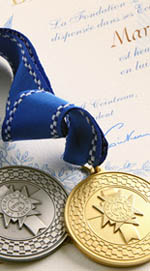
Celebrate Bastille Day
Modern chocolate flan recipe
 Learn how to analyse a dish with Chef Éric Briffard, One of the Best Craftsmen in France (Meilleur Ouvrier de France - MOF), Le Cordon Bleu Paris Executive Chef, Culinary Arts Director.
Learn how to analyse a dish with Chef Éric Briffard, One of the Best Craftsmen in France (Meilleur Ouvrier de France - MOF), Le Cordon Bleu Paris Executive Chef, Culinary Arts Director.
Analysing a dish is, above all, using all of our senses: sight, smell, hearing, touch and taste. It is also seeking its identity and evaluating it through taste. Analysing a dish is therefore giving a sensorial judgement. It is being able to describe the flavours being tasted, and judging the quality of the products, enabling you to successfully categorize your taste impressions. The more experience one has in analysing, the more reliable the judgement will be. The analysis must be carried out in the correct conditions: a room which is well-ventilated, peaceful and well-lit and the person who is about to taste must avoid smoking or wearing too strong a perfume so that the senses are not impeded.
To leave an everlasting impression, a dish must surprise the person tasting it, create emotion, either by arousing curiosity, or by stimulating the senses through the way in which flavours are combined and constructed. How a dish is composed, its alchemy, how the 5 flavours (sourness, saltiness, bitterness, sweetness and umami), are divided up can provoke gourmet delight, emotion or childhood memories. Pure uninfluenced emotion is rare but unforgettable. Umami is the most recent of the five fundamental tastes. Up until the 1980s, only four tastes were recognized: sweetness, saltiness, sourness and bitterness. Also known as glutamate, umami directly stimulates the tongue.
We first discover a dish with our eyes.
The dish must be harmonious and balanced; its colours, shape, presentation or originality must be eye-catching. It must arouse our curiosity and make us really want to taste it, regardless of the technique or culinary style used (classic, new-style or evolutionary).
After the visual aspect, the aromas and flavours of the dish should awaken our sense of smell. The olfactory sense communicates the aromas of a dish or wine. Smell is a sense which works via association.
Before putting a dome cover over a dish of lamb, I always add a few sprigs of dried and smoking rosemary. Others use a spray or essential oil to create an ambiance and to influence the customer before they have even tasted the dish.
As we continue our journey of the senses, we arrive at hearing. The sound a dish makes can arouse our curiosity and stimulate our appetite: the crisp sound of a millefeuille when tapped with a fork or the crackle of roast chicken on its roasting dish for example.
The texture in the mouth reveals and accentuates how a dish tastes. A variety of textures will allow the dish to be appreciated in different ways (soft, hard, moist, crunchy, crisp), but also its consistency (fatty, dry, moist) as well as the temperature (hot, cold, warm, iced or boiling).
The consumer will then taste the dish with their palate, taste buds and tongue. This will reveal the texture, flavour complexity and alchemy.
A number of criteria will lead us to be able to provide a judgement on taste such as the temperature of the dish, the textures, the seasoning, the flavours of bitterness, sourness, sweetness or saltiness which lead to how the ingredients, contained in a dish, are balanced, and its harmony.
Even if all the senses are involved in analysing a dish, the strongest of all is taste.
In order to work out whether a dish is harmonious, each part of it should be taken and eaten in a single mouthful. This is the only way that we can identify whether or not the dish is balanced and harmonious.
All the elements that make up a dish should respond to one another and interconnect in order to produce a flavour which is pleasant, tasty and balanced in the mouth.
Other criteria, which are more or less subjective, will also form part of the consideration when analyzing a dish: like, for example, its name which should make you want to try it, the desire to make something really appealing whilst respecting the elements which make up the dish. Was the dish as good as we thought it was before we tasted it? It is also important to consider the ethics and the origin of the consumer before making a dish, as each culture has its own particular codes.
A great dish must provide the person eating it with a real sense of pleasure: an emotion! It will leave an everlasting impression, evoke something exceptional, outstanding. It will be a dish that will be remembered as a signature dish.




Copyright © 2025 Le Cordon Bleu International B.V. All Rights Reserved.